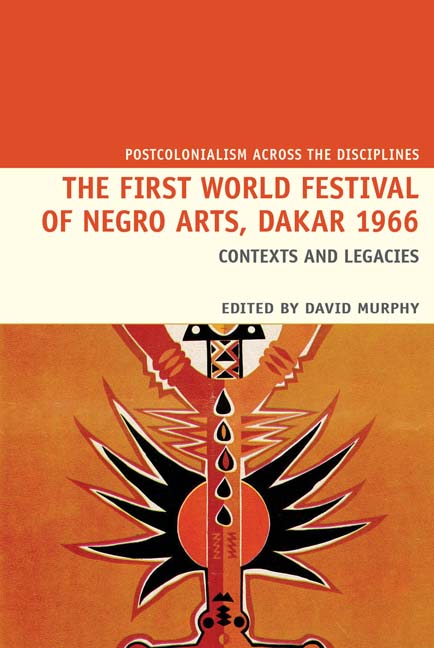Book contents
- Frontmatter
- Contents
- Acknowledgements
- List of Figures
- Notes on Contributors
- Introduction. The Performance of Pan-Africanism: Staging the African Renaissance at the First World Festival of Negro Arts
- I Contexts
- 1 ‘The Real Heart of the Festival’: The Exhibition of L'Art nègre at the Musée Dynamique
- 2 Dance at the 1966 World Festival of Negro Arts: Of ‘Fabulous Dancers’ and Negritude Undermined
- 3 Staging Culture: Senghor, Malraux and the Theatre Programme at the First World Festival of Negro Arts
- 4 Making History: Performances of the Past at the 1966 World Festival of Negro Arts
- 5 ‘The Next Best Thing to Being There’: Covering the 1966 Dakar Festival and its Legacy in Black Popular Magazines
- II Legacies
- Books and Films about the 1966 Festival
- Bibliography
- Index
1 - ‘The Real Heart of the Festival’: The Exhibition of L'Art nègre at the Musée Dynamique
from I - Contexts
- Frontmatter
- Contents
- Acknowledgements
- List of Figures
- Notes on Contributors
- Introduction. The Performance of Pan-Africanism: Staging the African Renaissance at the First World Festival of Negro Arts
- I Contexts
- 1 ‘The Real Heart of the Festival’: The Exhibition of L'Art nègre at the Musée Dynamique
- 2 Dance at the 1966 World Festival of Negro Arts: Of ‘Fabulous Dancers’ and Negritude Undermined
- 3 Staging Culture: Senghor, Malraux and the Theatre Programme at the First World Festival of Negro Arts
- 4 Making History: Performances of the Past at the 1966 World Festival of Negro Arts
- 5 ‘The Next Best Thing to Being There’: Covering the 1966 Dakar Festival and its Legacy in Black Popular Magazines
- II Legacies
- Books and Films about the 1966 Festival
- Bibliography
- Index
Summary
The exhibition, L'Art nègre/Negro Art: Sources, Evolution, Expansion, was (alongside the similarly themed colloquium), the major highlight of the Premier Festival mondial des arts nègres. It was also the event that attracted by far the most attention from the world's press. For instance, the USA-based scholar John Povey categorically affirmed that: ‘The traditional museum pieces were remarkable. A single visit to this exhibition made the trip to Dakar already worthwhile’ (1966: 26). In the build-up to the festival, the Senegalese newspaper, Dakar-Matin, published regular progress reports on preparations for the exhibition, as well as updates on the construction of the event's purpose-built home, the Musée Dynamique (Figure 6). This was the first time that the ‘masterpieces’ of African art had been gathered together under one roof in Africa: this involved not only art works held in museums and private collections in Europe and America but also pieces that remained in Africa as part of the continent's still vibrant cultural heritage. After Dakar, the exhibition transferred to Paris that summer for a show that inaugurated a brand new exhibition space within the Grand Palais.
On 30 March, the day before the exhibition opened, the festival was launched by a colloquium held in Senegal's National Assembly. Over the course of a week, speakers debated ‘The Function and significance of negro art in the lives of and for the people’, a theme that echoed earlier discussions at the Congrès des artistes et écrivains noirs held in Paris (1956) and Rome (1959). The debates centred on establishing an inventory of African cultural riches, identifying new cultural forms and exploring the notion of cultural unity. The festival had been charged with affirming the global recognition of ‘black culture’ through a comprehensive demonstration of its key cultural and artistic achievements. In light of this, the exhibition can be seen to have provided aesthetic support for the colloquium, as well as giving expression, through the representative sample of works exhibited, to the desire to provide a synoptic history of African art. However, the attention that the exhibition drew risked diverting observers from the other main preoccupation of the colloquium, namely to lay the foundations for Africa's cultural future.
- Type
- Chapter
- Information
- The First World Festival of Negro Arts, Dakar 1966Contexts and legacies, pp. 55 - 73Publisher: Liverpool University PressPrint publication year: 2016



